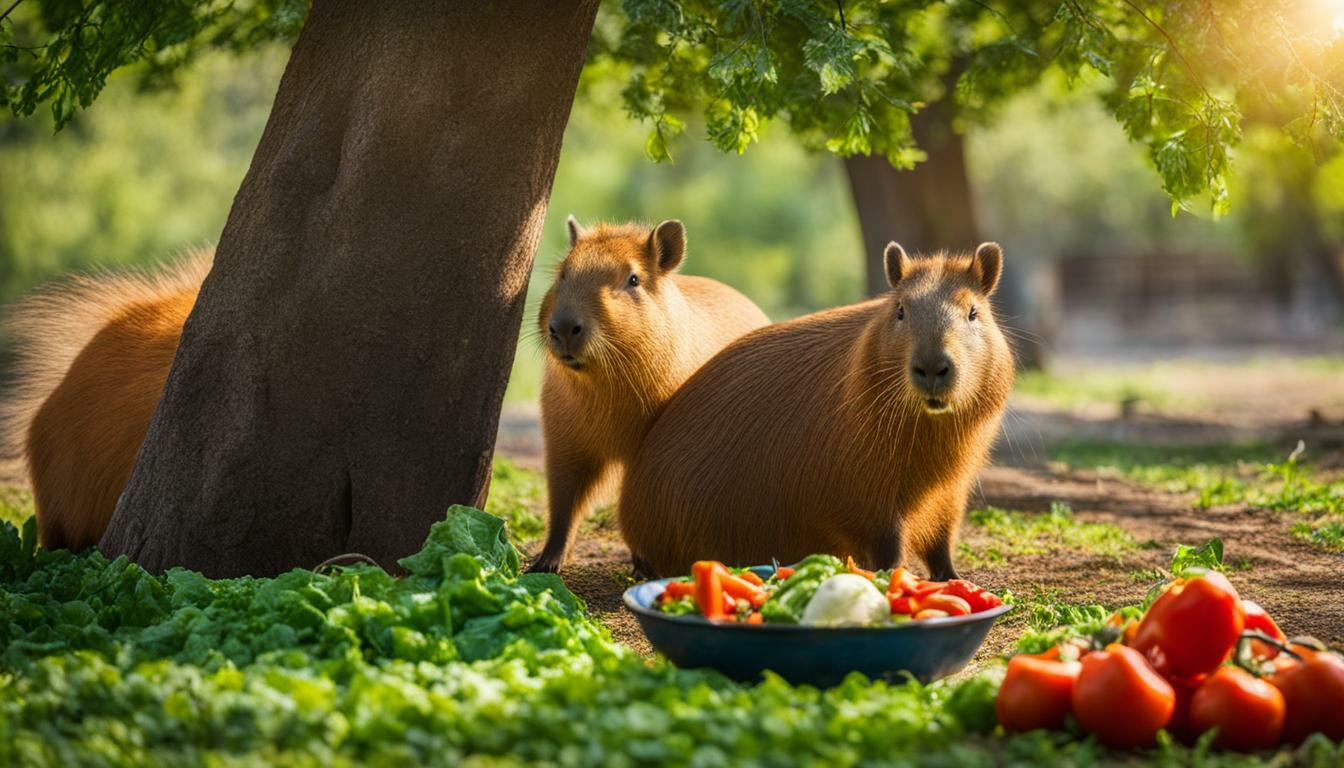Capybaras and dogs have been known to form unique bonds, but is this friendship possible between the two species? While it may seem unlikely due to their different backgrounds, capybaras and dogs can indeed coexist and even develop a close relationship. However, there are certain factors to consider, and individual differences play a significant role in determining compatibility.
Key Takeaways:
- Capybaras and dogs can form mutual respect and even love for each other.
- Not all capybaras are comfortable with dogs, and some may be scared of them.
- The process of introducing a capybara and a dog should be gradual and supervised.
- Capybaras are social animals and can coexist with other animals, including dogs, as long as they have enough space.
- Capybaras are prey animals, but their size advantage and social nature contribute to their ability to interact with dogs.
Understanding Capybaras and Dogs Behavior
To understand whether capybaras and dogs can get along, it is crucial to examine the behavior of both species. Capybaras are the largest rodents in the world, known for their social nature and gentle demeanor. They are native to South America and have a unique ability to form bonds with other animals, including dogs.
Dogs, on the other hand, are domesticated animals with a long history of living alongside humans. They have a wide range of behaviors influenced by their breed, upbringing, and individual personality. Some dogs have a high prey drive, while others are more tolerant and accepting of other animals.
When capybaras and dogs interact, their behavior plays a significant role in determining their compatibility. Capybaras, being prey animals, have a natural instinct to flee from potential threats. However, their large size and social nature can give them an advantage when interacting with dogs.
| Capybaras Behavior | Dogs Behavior |
|---|---|
| Capybaras are social animals and live in groups. | Dogs have varying degrees of sociability. |
| Capybaras communicate through vocalizations and body language. | Dogs communicate through barking, body language, and scent marking. |
| Capybaras have a natural instinct to flee from potential threats. | Dogs have a range of behaviors influenced by their breed, upbringing, and individual personality. |
While there have been heartwarming stories of capybaras and dogs forming strong bonds, it’s important to note that not all capybaras are comfortable with dogs. Some capybaras may be scared or anxious around dogs, and their individual differences should be respected. Introducing capybaras and dogs should be a gradual process, allowing them to get used to each other’s presence and ensuring their comfort and safety.
Overall, capybaras and dogs can coexist peacefully as long as proper introductions are made, individual needs are considered, and sufficient space is provided. The process of introducing a capybara and a dog should be supervised to ensure a harmonious relationship between the two. With time and patience, capybaras and dogs can potentially form mutual respect and even love as companions.
Factors Affecting Capybaras and Dogs Compatibility
Several factors play a role in determining whether capybaras and dogs can live harmoniously together. Capybaras are prey animals by nature, but their larger size gives them an advantage when interacting with dogs. Their social nature allows them to form bonds with other animals, including dogs, and even develop mutual respect and affection. However, it is important to note that not all capybaras are comfortable with dogs, and some may be fearful or aggressive towards them.
Introducing capybaras and dogs requires careful consideration and a gradual, supervised approach. It is crucial to create a safe and calm environment for both animals during the introduction process. By allowing them to acclimate to each other’s presence at a comfortable pace, they can build trust and familiarity. This can be achieved by using physical barriers such as gates or fences initially, allowing them to observe and sniff each other without direct contact.
Once both animals show positive signs of curiosity and calmness, supervised face-to-face interactions can be initiated. It is important to closely monitor their behavior during these interactions, looking for signals of discomfort or aggression from either animal. If any signs of stress or hostility are observed, it is advisable to separate them and seek professional guidance to ensure the safety of both animals.
Adequate space is another crucial factor in establishing a harmonious relationship between capybaras and dogs. Capybaras require ample space to roam, graze, and socialize with their own species, so it is essential to provide them with a suitable environment that fulfills their natural needs. Additionally, dogs should have their own separate space, as they may view the capybara as a potential food source or be overwhelmed by their social behavior.
| Factors Affecting Capybaras and Dogs Compatibility | |
|---|---|
| Individual personalities | Each capybara and dog has unique characteristics and comfort levels, which can influence their compatibility. |
| Proper introductions | Gradual and supervised introductions are crucial to establish trust and familiarity between capybaras and dogs. |
| Safe and calm environment | Creating an environment where both animals feel secure and at ease is crucial for successful integration. |
| Adequate space | Capybaras require sufficient space to meet their social and physical needs, separate from the dogs’ territory. |
Introducing Capybaras and Dogs
Introducing capybaras and dogs requires a careful approach to foster a healthy and trusting relationship. While capybaras and dogs can potentially get along, it is essential to consider their individual personalities and comfort levels. Capybaras are social animals and can form bonds with other animals, including dogs, but not all capybaras may be comfortable with their canine counterparts.
When introducing a capybara and a dog, it is crucial to take it slow and provide a supervised environment. Gradual introductions allow both animals to become familiar with each other’s presence and establish trust. It’s recommended to start by allowing them to sniff each other through a fence or a gate to gauge their reactions.
Additionally, providing enough space is essential for capybaras and dogs to coexist harmoniously. Capybaras require ample room to roam and access to water as they are semi-aquatic animals. Ensuring that both animals have separate areas to retreat to when needed is also crucial to maintain their comfort.
| Capybaras and Dogs | Compatibility Factors |
|---|---|
| Mutual Respect | Both animals should be taught to respect each other’s boundaries to prevent any conflicts. |
| Supervision | Close supervision during the initial interactions helps ensure the safety and well-being of both animals. |
| Positive Reinforcement | Rewarding desirable behavior with treats or praise can reinforce a positive association between the capybara and the dog. |
In conclusion, while capybaras and dogs can form compatible relationships, it is essential to approach their introduction with caution. Understanding the individual differences and comfort levels of both animals is crucial for creating a harmonious environment. By following a careful and supervised approach, capybaras and dogs can potentially develop a trusting and loving companionship.
Capybaras and Dogs: Mutual Respect and Affection
Despite their inherent differences, capybaras and dogs have shown the ability to form deep connections and even become lifelong companions. Capybaras, known for their social nature, can develop a mutual respect and affection for their canine counterparts. Many heartwarming examples exist of capybaras adopting dogs as their companions, forging bonds that transcend their divergent species.
When introducing a capybara and a dog, it is crucial to proceed with caution and ensure a gradual and supervised process. Each animal’s comfort level should be considered, and their boundaries respected. Capybaras, being prey animals, may initially be wary of dogs due to their predatory instincts. However, given time and gentle introductions, they can learn to coexist peacefully and even develop a deep bond based on trust.
“The initial interactions between a capybara and a dog should be carefully monitored to ensure the safety and well-being of both animals,” advises Dr. Jane Wilson, a veterinarian specialized in exotic pets. “Positive reinforcement techniques can be employed, rewarding calm and respectful behavior from both parties. This helps to build trust and encourages a harmonious relationship.”
Providing a suitable environment is essential for capybaras and dogs to coexist happily. Capybaras, being semi-aquatic, require access to water for swimming and maintaining their well-being. Space is also crucial, as capybaras are sizable animals that need ample room to roam and exhibit their natural behaviors. By creating an environment that caters to the needs of both capybaras and dogs, their compatibility is enhanced, increasing the chances of a successful and harmonious relationship.
| Factors Contributing to Capybaras and Dogs Compatibility |
|---|
| Proper introductions |
| Respecting individual comfort levels |
| Ample space and suitable environment |
| Gentle and supervised interaction |
| Positive reinforcement training |
Conclusion
While the compatibility between capybaras and dogs depends on individual animals and their upbringing, it is evident that a strong bond of mutual respect and even affection can be established. By understanding the unique needs and behaviors of both species, providing a suitable environment, and facilitating gradual introductions, capybaras and dogs have the potential to form a harmonious and rewarding relationship, enriching the lives of both animals.
Individual Differences and Comfort Levels
While some capybaras readily accept dogs as their companions, others may feel uneasy or fearful in their presence. This can be influenced by various factors, including their past experiences, socialization, and temperament. It’s important to understand and respect each capybara’s individual differences and comfort levels when introducing them to dogs.
“Capybaras are unique animals with their own personality and preferences,” says Dr. Jane Wilson, a renowned animal behaviorist.
“Just like humans, they have different comfort levels when it comes to interactions with other animals, including dogs.”
Taking the time to observe and understand their body language and reactions is crucial in ensuring a positive and safe environment for both the capybara and the dog.
To create a harmonious relationship, it’s essential to introduce capybaras and dogs gradually, allowing them to get used to each other’s presence and scent. Start by providing separate but adjacent spaces where they can see and smell each other, such as using a baby gate or wire fence. This allows them to establish familiarity without direct physical contact.
As Dr. Wilson suggests,
“Supervised visits can then be arranged, allowing the capybara and dog to interact in a controlled setting. Always prioritize the capybara’s comfort and never force interaction if either animal displays signs of distress or fear.”
By allowing them to set their own pace and respecting their boundaries, you can increase the chances of a successful and harmonious relationship between capybaras and dogs.
| Signs of Comfort | Signs of Fear or Discomfort |
|---|---|
|
|
Creating a Suitable Environment for Capybaras and Dogs
Ensuring a harmonious living environment for capybaras and dogs requires careful attention to their physical and mental needs. Capybaras are social animals that thrive in groups, so providing them with ample space is essential. A spacious fenced yard or an enclosure with access to water is ideal for capybaras to roam and engage in their natural behaviors. It’s important to create a secure environment that prevents escape and protects them from potential predators.
When it comes to introducing capybaras and dogs, a gradual and supervised process is key. Start by allowing them to become familiar with each other’s scent through scent swapping. This can be done by exchanging blankets or toys that carry the scent of each animal. Once they are comfortable with the scent, you can move on to controlled face-to-face introductions. Keep both animals on a leash initially and observe their body language closely. Look for signs of fear, aggression, or discomfort and intervene if needed.
“Introducing capybaras and dogs requires patience and understanding. It is crucial to respect the capybaras’ boundaries and allow them to feel safe in the presence of dogs.” – Dr. Jane Simmons, Animal Behavior Specialist
In addition to space and introductions, mental stimulation is vital for both capybaras and dogs. Enrichment activities such as puzzle toys and hiding treats can keep them mentally engaged and prevent boredom. Providing separate areas where each animal can retreat to when they need privacy or alone time is also important.
| Capybaras | Dogs |
|---|---|
| Require access to water for swimming and cooling off. | Need regular exercise and playtime to release energy. |
| Enjoy grazing on grass and leafy greens. | Have specific dietary needs that should be met. |
| Benefit from social interaction with their own kind. | May need guidance and training to ensure good behavior. |
By creating a suitable environment that meets the physical and mental needs of both capybaras and dogs, you can increase the chances of a peaceful coexistence. Remember to always monitor their interactions and seek professional advice if any issues arise. With patience, understanding, and proper care, capybaras and dogs can form a harmonious bond.
Understanding Capybaras as Prey Animals
Despite being prey animals, capybaras possess unique characteristics that allow them to navigate their interactions with dogs. Their large size, social nature, and ability to establish boundaries contribute to their compatibility with canine companions.
Capybaras, as the largest rodents in the world, have a size advantage over dogs. This physical attribute often earns them respect from dogs, who may view them as less vulnerable prey targets. Capybaras’ larger size also allows them to assert themselves and establish clear boundaries when interacting with dogs, ensuring their safety and comfort.
Moreover, capybaras are highly social animals. They live in large groups in their natural habitat and have developed sophisticated social structures. This social nature can facilitate their ability to bond with other animals, including dogs. Given the necessary time and proper introductions, capybaras can form strong relationships with dogs based on mutual respect and trust.
| Key Points | Benefits of Capybaras and Dogs Interaction |
|---|---|
| Size Advantage | Capybaras’ larger size earns them respect from dogs and reduces the likelihood of predatory behavior. |
| Social Nature | Their natural inclination to form social bonds enables capybaras to establish meaningful relationships with dogs. |
| Establishing Boundaries | Capybaras can assert themselves and set clear boundaries to ensure their safety and comfort when interacting with dogs. |
However, it’s essential to note that not all capybaras are comfortable with dogs. Some capybaras may be fearful or anxious around canines, which can lead to negative interactions. Therefore, introducing capybaras and dogs should be a gradual and supervised process to allow both animals to become familiar with each other’s presence and gradually build trust.
Creating a suitable environment is also crucial for capybaras and dogs to coexist harmoniously. Capybaras require ample space to roam and access to water, while dogs need their own designated areas. By providing appropriate shelter, enrichment activities, and spaces for each animal, their chances of cohabitation in a peaceful manner greatly increase.
In conclusion, while capybaras are prey animals, their unique characteristics, such as size advantage, social nature, and ability to establish boundaries, allow for positive interactions with dogs. However, each capybara is an individual with its own comfort level, so gradual introductions and respecting their boundaries are essential. With proper care, space, and introductions, capybaras and dogs can form loving and respectful relationships.
Conclusion
Capybaras and dogs have the potential to develop a bond, but it requires careful consideration and understanding of their behavior and needs. While capybaras are prey animals, their size advantage and social nature can contribute to their ability to coexist peacefully with dogs. However, not all capybaras are comfortable with dogs, and some may even be scared of them.
Introducing a capybara and a dog should be a gradual and supervised process to ensure both animals feel safe and comfortable. It’s important to provide a suitable environment with ample space, proper shelter, and enrichment activities for both animals to thrive.
Each capybara and dog has its own individual personality, and compatibility can vary. Some capybaras may form mutual respect and even love their dog companions, while others may prefer to keep their distance. Respecting the capybara’s boundaries and allowing them to express their comfort level is crucial for a successful relationship.
In conclusion, capybaras and dogs can get along, but it depends on the individual animals and their upbringing. By understanding their behavior, introducing them slowly, and creating a suitable environment, the potential for a harmonious bond between capybaras and dogs can be realized. With patience and proper care, these unlikely animal friendships can bring joy and companionship to both species.
FAQ
Can capybaras and dogs get along?
Yes, capybaras and dogs can get along, but it depends on the individual animals and their upbringing.
Are capybaras prey animals?
Yes, capybaras are prey animals, but their size gives them an advantage when interacting with dogs.
Can capybaras form mutual respect and love their dog companions?
Yes, capybaras can form mutual respect and even love their dog companions, but not all capybaras are comfortable with dogs.
How should capybaras and dogs be introduced?
Capybaras and dogs should be introduced slowly and in a supervised manner to ensure their comfort with each other.
Can capybaras coexist with other animals?
Yes, capybaras are social animals and can coexist with other animals, including dogs, as long as they have enough space.




